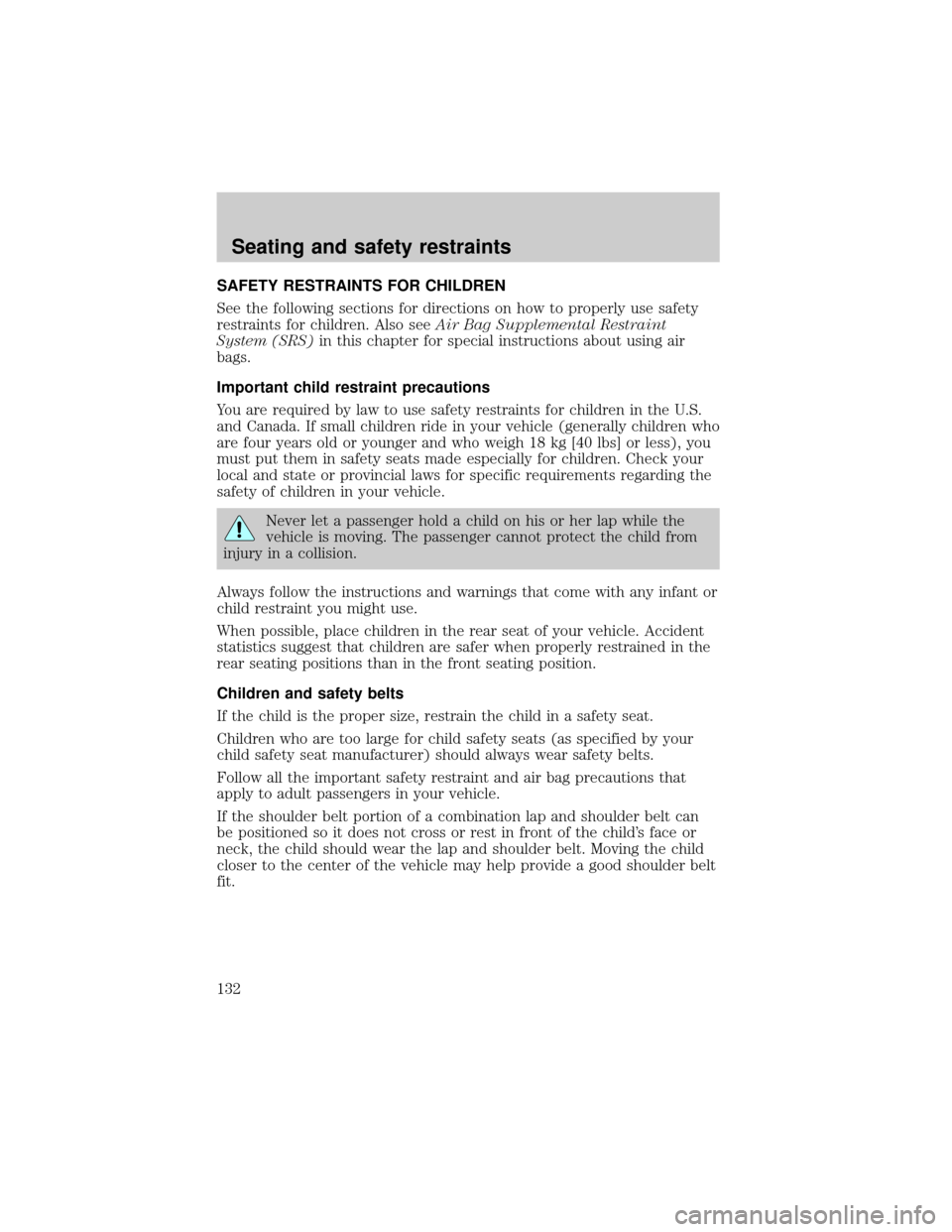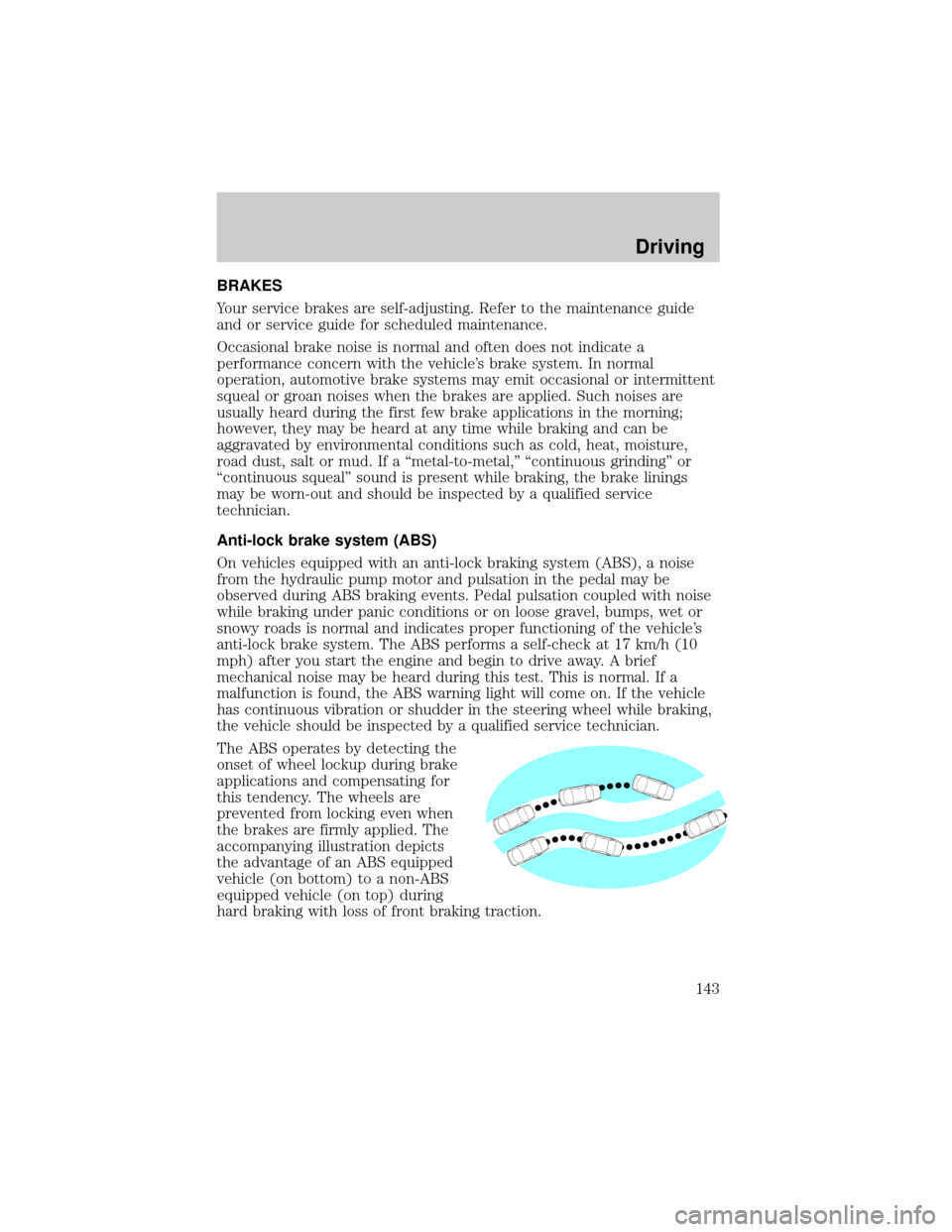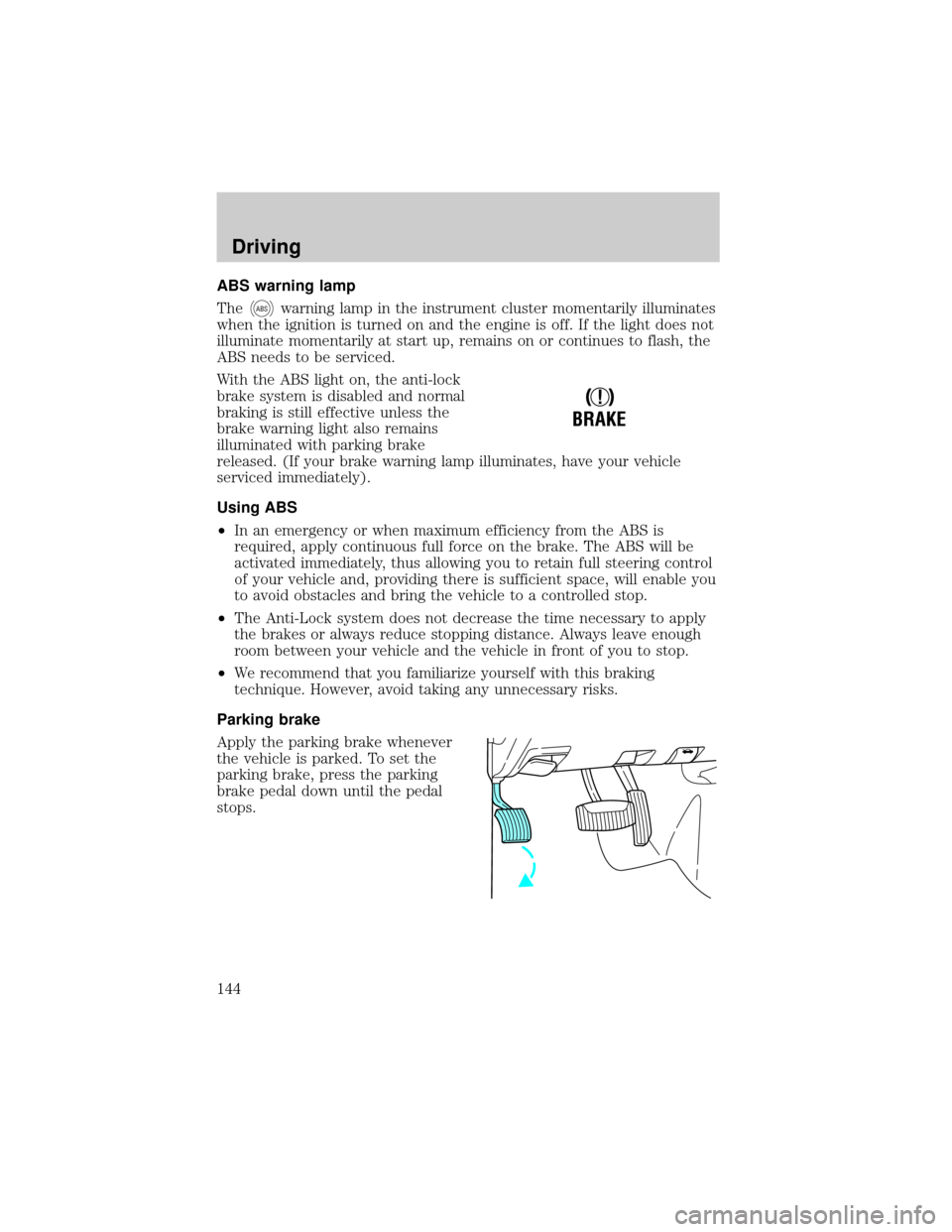warning Mercury Mountaineer 1999 s User Guide
[x] Cancel search | Manufacturer: MERCURY, Model Year: 1999, Model line: Mountaineer, Model: Mercury Mountaineer 1999Pages: 248, PDF Size: 1.74 MB
Page 132 of 248

SAFETY RESTRAINTS FOR CHILDREN
See the following sections for directions on how to properly use safety
restraints for children. Also seeAir Bag Supplemental Restraint
System (SRS)in this chapter for special instructions about using air
bags.
Important child restraint precautions
You are required by law to use safety restraints for children in the U.S.
and Canada. If small children ride in your vehicle (generally children who
are four years old or younger and who weigh 18 kg [40 lbs] or less), you
must put them in safety seats made especially for children. Check your
local and state or provincial laws for specific requirements regarding the
safety of children in your vehicle.
Never let a passenger hold a child on his or her lap while the
vehicle is moving. The passenger cannot protect the child from
injury in a collision.
Always follow the instructions and warnings that come with any infant or
child restraint you might use.
When possible, place children in the rear seat of your vehicle. Accident
statistics suggest that children are safer when properly restrained in the
rear seating positions than in the front seating position.
Children and safety belts
If the child is the proper size, restrain the child in a safety seat.
Children who are too large for child safety seats (as specified by your
child safety seat manufacturer) should always wear safety belts.
Follow all the important safety restraint and air bag precautions that
apply to adult passengers in your vehicle.
If the shoulder belt portion of a combination lap and shoulder belt can
be positioned so it does not cross or rest in front of the child's face or
neck, the child should wear the lap and shoulder belt. Moving the child
closer to the center of the vehicle may help provide a good shoulder belt
fit.
Seating and safety restraints
132
Page 143 of 248

BRAKES
Your service brakes are self-adjusting. Refer to the maintenance guide
and or service guide for scheduled maintenance.
Occasional brake noise is normal and often does not indicate a
performance concern with the vehicle's brake system. In normal
operation, automotive brake systems may emit occasional or intermittent
squeal or groan noises when the brakes are applied. Such noises are
usually heard during the first few brake applications in the morning;
however, they may be heard at any time while braking and can be
aggravated by environmental conditions such as cold, heat, moisture,
road dust, salt or mud. If a ªmetal-to-metal,º ªcontinuous grindingº or
ªcontinuous squealº sound is present while braking, the brake linings
may be worn-out and should be inspected by a qualified service
technician.
Anti-lock brake system (ABS)
On vehicles equipped with an anti-lock braking system (ABS), a noise
from the hydraulic pump motor and pulsation in the pedal may be
observed during ABS braking events. Pedal pulsation coupled with noise
while braking under panic conditions or on loose gravel, bumps, wet or
snowy roads is normal and indicates proper functioning of the vehicle's
anti-lock brake system. The ABS performs a self-check at 17 km/h (10
mph) after you start the engine and begin to drive away. A brief
mechanical noise may be heard during this test. This is normal. If a
malfunction is found, the ABS warning light will come on. If the vehicle
has continuous vibration or shudder in the steering wheel while braking,
the vehicle should be inspected by a qualified service technician.
The ABS operates by detecting the
onset of wheel lockup during brake
applications and compensating for
this tendency. The wheels are
prevented from locking even when
the brakes are firmly applied. The
accompanying illustration depicts
the advantage of an ABS equipped
vehicle (on bottom) to a non-ABS
equipped vehicle (on top) during
hard braking with loss of front braking traction.
Driving
143
Page 144 of 248

ABS warning lamp
The
ABSwarning lamp in the instrument cluster momentarily illuminates
when the ignition is turned on and the engine is off. If the light does not
illuminate momentarily at start up, remains on or continues to flash, the
ABS needs to be serviced.
With the ABS light on, the anti-lock
brake system is disabled and normal
braking is still effective unless the
brake warning light also remains
illuminated with parking brake
released. (If your brake warning lamp illuminates, have your vehicle
serviced immediately).
Using ABS
²In an emergency or when maximum efficiency from the ABS is
required, apply continuous full force on the brake. The ABS will be
activated immediately, thus allowing you to retain full steering control
of your vehicle and, providing there is sufficient space, will enable you
to avoid obstacles and bring the vehicle to a controlled stop.
²The Anti-Lock system does not decrease the time necessary to apply
the brakes or always reduce stopping distance. Always leave enough
room between your vehicle and the vehicle in front of you to stop.
²We recommend that you familiarize yourself with this braking
technique. However, avoid taking any unnecessary risks.
Parking brake
Apply the parking brake whenever
the vehicle is parked. To set the
parking brake, press the parking
brake pedal down until the pedal
stops.
!
BRAKE
Driving
144
Page 145 of 248

The BRAKE warning lamp in the
instrument cluster illuminates and
remains illuminated (when the
ignition is turned ON) until the
parking brake is released.
Always set the parking brake fully and make sure that the
gearshift is securely latched in P (Park).
The parking brake is not recommended to stop a moving vehicle.
However, if the normal brakes fail, the parking brake can be used to stop
your vehicle in an emergency. Since the parking brake applies only the
rear brakes, the vehicle's stopping distance will increase greatly and the
handling of your vehicle will be adversely affected.
Pull the release lever to release the
brake. Driving with the parking
brake on will cause the brakes to
wear out quickly and reduce fuel
economy.
AIR SUSPENSION SYSTEM (IF EQUIPPED)
The load leveling feature of the air suspension automatically keeps the
vehicle at a constant level if a load is added or removed from the vehicle.
This system maintains the vehicle height at a constant level by
automatically adding air or releasing air from the springs to offset
changes in vehicle loads.
When ever a door is opened (including the liftgate) the system
memorizes and maintains the height of the vehicle until all doors are
closed.
It is normal to hear a buzz or clicking from the air compressor on the
vehicle when the ignition is turned off. The system stays energized for 40
minutes after the ignition is turned off to compensate for any load
changes made after the vehicle is parked.
!
BRAKE
Driving
145
Page 147 of 248

Do not rock the vehicle for more than a few minutes. The
transmission and tires may be damaged or the engine may
overheat.
Always set the parking brake fully and make sure the gearshift is
latched in P (Park). Turn off the ignition whenever you leave
your vehicle.
If the parking brake is fully released, but the brake warning lamp
remains illuminated, the brakes may not be working properly.
See your dealer or a qualified service technician.
Driving with a 4±speed automatic transmission (if equipped)
Understanding gearshift positions
Pull the gearshift lever towards you and downward to move the
automatic gearshift.
Hold the brake pedal down while you move the gearshift lever
from P (Park) to another position. If you do not hold the brake
pedal down, your vehicle may move unexpectedly and injure someone.
P (Park)
Always come to a complete stop
before shifting into P (Park). Make
sure the gearshift is securely latched
in P (Park). This position locks the
transmission and prevents the rear
wheels from turning.
Always set the parking brake fully and make sure the gearshift is
securely latched in P (Park).
Never leave your vehicle unattended while it is running.
Driving
147
Page 221 of 248

EMISSION CONTROL SYSTEM
Your vehicle is equipped with various emission control components and a
catalytic converter which will enable your vehicle to comply with
applicable exhaust emission standards. To make sure that the catalytic
converter and other emission control components continue to work
properly:
²Use only unleaded fuel.
²Avoid running out of fuel.
²Do not turn off the ignition while your vehicle is moving, especially at
high speeds.
²Have the items listed in your Scheduled Maintenance Guide performed
according to the specified schedule.
The scheduled maintenance items listed in the Scheduled Maintenance
Guide are essential to the life and performance of your vehicle and to its
emissions system.
If other than Ford, Motorcraft or Ford-authorized parts are used for
maintenance replacements or for service of components affecting
emission control, such non-Ford parts should be equivalent to genuine
Ford Motor Company parts in performance and durability.
Do not park, idle, or drive your vehicle in dry grass or other dry
ground cover. The emission system heats up the engine
compartment and exhaust system, which can start a fire.
Illumination of the charging system warning light, ªCheck Engineº light
or the temperature warning light, fluid leaks, strange odors, smoke or
loss of oil pressure, could indicate that the emission control system is
not working properly.
Exhaust leaks may result in entry of harmful and potentially
lethal fumes into the passenger compartment.
Maintenance and care
221
Page 222 of 248

Do not make any unauthorized changes to your vehicle or engine. By
law, vehicle owners and anyone who manufactures, repairs, items, sells,
leases, trades vehicles, or supervises a fleet of vehicles are not permitted
to intentionally remove an emission control device or prevent it from
working. Information about your vehicle's emission system is on the
Vehicle Emission Control Information Decal located on or near the
engine. This decal identifies engine displacement and gives some tune up
specifications.
Please consult your ªWarranty Guideº for complete emission warranty
information.
Readiness for inspection/maintenance (I/M) testing
In some localities, it may be a legal requirement to pass an I/M test of
the on-board diagnostic (OBD-II) system. If your ªCheck Engine/Service
Engine Soonº light is on, refer to the description in theWarning Lights
and Chimessection of theInstrumentationchapter. Your vehicle may
not pass the I/M test with the ªCheck Engine/Service Engine Soonº light
on.
If the vehicle's powertrain system or its battery has just been serviced,
the OBD-II system is reset to a ªnot ready for I/M testº condition. To
ready the OBD-II system for I/M testing, a minimum of 30 minutes of city
and highway driving is necessary as described below:
²First, at least 10 minutes of driving on an expressway or highway.
²Next, at least 20 minutes driving in stop-and-go, city-type traffic with
at least four idle periods.
Allow the vehicle to sit for at least eight hours without starting the
engine. Then, start the engine and complete the above driving cycle. The
engine must warm up to its normal operating temperature. Once started,
do not turn off the engine until the above driving cycle is complete.
EXTERIOR BULBS
Replacing exterior bulbs
Check the operation of the following lamps frequently:
²Headlamps
²Foglamps
²High-mount brakelamp
²Brakelamps
Maintenance and care
222
Page 242 of 248

Air bag supplemental restraint
system ........................................125
and child safety seats ............127
description .......................126,129
disposal ....................................131
indicator light ..................129,131
passenger air bag ............127,130
Air conditioning
automatic temperature
control system..24,25,26,27,28,29
rear seat controls .....................30
Air suspension
description ..............................145
warning light .............................10
All Wheel Drive (AWD),
driving off road .........................157
Armrests ....................................103
Automatic transmission
driving an automatic
overdrive ..................147,148,149,
150,151,152
Axle
refill capacities ........................233
Battery
voltage gauge ............................14
Brakes ........................................143
anti-lock ............................143,144
anti-lock brake system (ABS)
warning light ...........................144
fluid, checking and adding ....197
shift interlock ..........................146
Break-in period ..........................2,3
Cargo area shade ......................104
Cargo cover ...............................104
CD player .....................76,78,79,80
Child safety seats
attaching with tether straps ..137
in rear seat ..............................135
tether anchorage hardware ...138
Cleaning your vehicle ...............227
engine compartment ..............228
exterior .............................228,230exterior lamps .........................230
interior .....................................231
plastic parts ............................230
washing ....................................227
waxing .....................................228
wheels ......................................229
windows ..................................232
wiper blades ............................230
woodtone trim ........................232
Compass, electronic ....................90
calibration .................................92
set zone adjustment .................91
Console ...............................101,102
overhead ...............................87,88
rear ..........................................102
Controls
power seat ........................116,118
Coolant ......................................201
checking and adding ..............199
refill capacities ........................201
Defrost
rear window ..............................31
Driveline universal joint and
slip yoke ....................................205
Driving under special
conditions ...........................156,159
sand ..................................156,158
snow and ice ......155,157,158,160
through water ..................156,158
Emission control system ..........221
Engine
check engine/service engine
soon light ....................................6
coolant .....................................199
idle speed control ...................206
service points ...................193,194
starting after a collision .........169
Engine block heater .................141
Engine oil
checking and adding ..............196
dipstick ....................................194
specifications ...................194,196
Index
242
Page 243 of 248

Exhaust fumes ..........................142
Floor mats .................................103
Four-Wheel Drive
vehicles ..............................9,10,152
control trac .............................152
description ................153,154,155
driving off road ................155,158
electronic shift ..........................32
Fuel
choosing the right fuel ...........214
comparisons with EPA fuel
economy estimates .................220
detergent in fuel .....................215
filling your vehicle with fuel....213,
216
gauge .........................................15
quality ......................................215
running out of fuel .................216
safety information relating to
automotive fuels .....................213
Fuses ............................170,171,172
Gas mileage (see
Fuel economy) .....217,218,219,220
Gauges .........................................11
engine coolant temperature
gauge .........................................12
engine oil pressure gauge ........14
GVWR (Gross Vehicle
Weight Rating)
calculating ...............................162
Hazard flashers .........................169
Headlamps
aiming ......................................227
autolamp system ..................97,98
bulb specifications ..................226
high beam ..............................9,20
warning chime ..........................11
Heating ........................................21
heating and air conditioning
system .............................21,22,23
Hood ..........................................192
Ignition .......................................237Inspection/maintenance (I/M)
testing ........................................222
Instrument panel
cleaning ...................................231
Keyless entry system
autolock ............................109,110
keypad .....................................111
locking and unlocking doors ..112
programming entry
code ..................................111,112
Keys
key in ignition chime ...............11
positions of the ignition ...........80
Lamps
daytime running light ...............20
fog lamps ...................................20
headlamps .................................20
headlamps, flash to pass ..........21
instrument panel, dimming .....21
replacing bulbs ................222,223
,224,225,226
Lane change indicator
(see Turn signal) ........................80
Liftgate ......................................103
Lights, warning and indicator
air bag ..........................................7
anti-lock brakes (ABS) ..............8
anti-theft .....................................9
brake ............................................8
charging system ..........................9
check coolant ..............................9
cruise indicator .........................10
door ajar ....................................10
fuel reset .....................................7
overdrive off ..............................10
safety belt ...................................8
speed control ............................84
turn signal indicator ...................8
Locks
childproof ................................100
Lumbar support, seats .............116
Message center ......................15,16
Index
243
Page 244 of 248

economy button ........................17
english/metric button ...............16
reset button ..............................17
system check button ...........17,18
Mirrors
automatic dimming rearview
mirror ........................................98
cleaning ...................................232
heated ......................................101
side view mirrors (power) .....101
Moon roof ....................................89
Motorcraft parts ........................217
Octane rating ............................215
Odometer .....................................13
Panic alarm feature, remote
entry system ..............................106
Parking brake ............................144
Power distribution box (see
Fuses) ........................................175
Power door locks ......................100
Power steering
fluid, checking and adding ....201
Radio ...34,35,36,37,38,39,40,41,42,
43,44,45,46,47,48,49,50,51,52,53,
54,55,57,58,59,60,61,62,63,64,65,
66,67,68,69
Relays ........................................170
Remote entry system .......105,113,
114,115
illuminated entry ....................109
locking/unlocking doors .........106
replacement/additional
transmitters .............................109
replacing the batteries ...........108
Reverse sensing system .............32
Roof rack ...................................167
Safety belts
(see Safety restraints) ...............11
Safety restraints
cleaning the safety belts .125,231
extension assembly ................124
for children .............................132warning light and chime ...11,124
Seat belts (see Safety
restraints) ......119,120,121,122,123
Seats ..........................................116
child safety seats ....................133
cleaning ............................230,231
memory seat ...........................107
Servicing your vehicle ..............191
Snowplowing .................................3
Spark plugs, specifications .......233
Special notice ................................3
ambulance conversions ..............3
utility-type vehicles ....................3
Specification chart, lubricants .235
Speed control ..............................81
Speedometer ...............................12
Starting your vehicle .........139,141
jump starting ............183,184,186
Steering wheel ............................86
tilting .........................................85
Tachometer .................................13
Tires ....................................209,210
changing ...........................178,179
checking the pressure ............210
replacing ..................................211
rotating ....................................210
snow tires and chains ............212
tire grades ...............................210
treadwear ................................209
Towing ..................163,165,166,167
recreational towing .................167
wrecker ....................................189
Traction-lok rear axle ...............160
Transfer case
fluid checking .........................205
Transmission ......................146,203
automatic operation ...............146
fluid, checking and adding
(automatic) ......................203,204
Trip odometer .............................13
Index
244